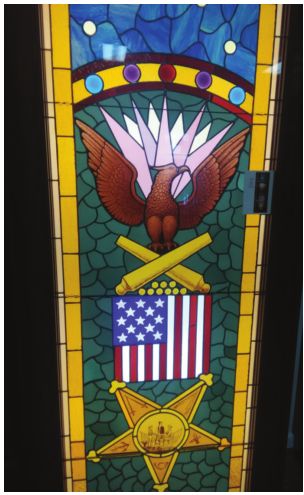
A museum in Springfield curated by direct descendants of Civil War veterans strives to honor their ancestors’ memory. Located at 503 South Walnut Street, the Daughters of Union Veterans of the Civil War (DUVCW) Museum allows visitors to study the lives of soldiers who fought in the Civil War.
Artifacts in the museum come from private collections donated by DUVCW members. “Most of the stuff that we have here was donated by daughters and granddaughters of war veterans,” Molly Kennedy, DUVCW administrative assistant, said. The DUVCW additionally showcases surviving photographs taken during the war. One such photo depicts a Union soldier held in Andersonville, a Confederate prison in Georgia notorious for its cruel treatment towards prisoners of war. The man is gaunt and looks severely malnourished. “The man passed away shortly after this photo was taken,” Kennedy said. “This photo is a frightening reminder how Andersonville was one of the worst places in the war.”
Another photo, which shows a doctor performing a battlefield amputation on a wounded solider, further illustrates the horrors of war. “This photo was taken by Mathew Brady, who usually had his subjects in a posed state,” said Kennedy. “I can’t imagine holding still for the 45 seconds it took to pose for the picture as someone is holding my leg while another person is holding a saw.”
Muskets and rifles that were used on the battlefield are also on display. The Springfield Model 1861 was a primary weapon for Union soldiers, as over 250,000 were produced in the first three years of the war. Noted for its range and accuracy in comparison to the Richmond rifles made by Confederate arms dealers, Kennedy believes the Springfield rifle was a critical advantage for the Union. “I believe it certainly helped the Union win the war, because the Confederates were not allowed to have those rifles,” she said.
A stained glass window of a bald eagle carrying golden scrolls of the American flag stands prominently near the back entrance of the museum. “This stained window was sent to us by a Grand Army of the Republic post in Maine,” Kennedy said. “The woman and her husband who donated the artwork had to take the glass apart and put it on the top of their car, which they drove all the way to Springfield from Maine.” The DUVCW then paid for the stained glass to be reconstructed to its original form, a process Kennedy said was funded through various fundraisers.
The museum doubles as the national headquarters for the DUVCW, which has been in Springfield since 1945. With a membership of over 7,000, the DUVCW has branches all over the country. DUVCW membership is restricted to daughters, granddaughters and great-granddaughters of Union veterans.
Kennedy talked about her own roots, starting with her great-grandfather. “My great-grandfather was a Union solider in a Missouri unit who served four years in Shiloh in Tennessee,” she said. “When he died in 1911 in central Illinois, he still had nine kids alive along with his widow, but at that time no obituary was published.”
Kennedy then explained the benefits of being a DUVCW member. “When you research the genealogy of your family’s history, it’s fun because you first learn of names and dates, but then you learn more about your ancestors and how they lived during that period,” said Kennedy. Located not far from downtown, the museum is free and open to the public year-round. Its operating hours are Tuesdays-Saturdays from 9:30 a.m. to 3:30 p.m.
Alex Camp is an editorial intern for Illinois Times. He is pursuing his master’s degree at University of Illinois Springfi eld. Contact him at [email protected].